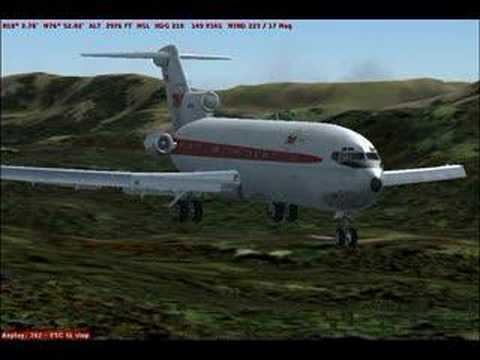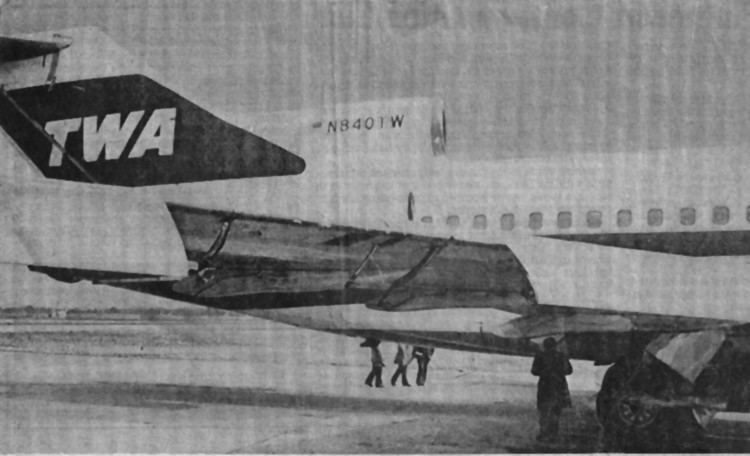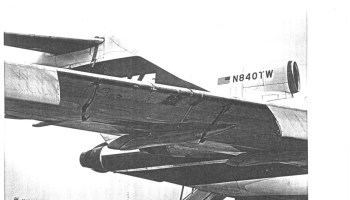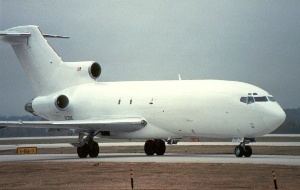Summary Uncontrolled descent Passengers 82 Fatalities 0 Date 4 April 1979 Injuries (nonfatal) 8 Survivor 89 (all) | Crew 7 Survivors 89 (all) Number of deaths 0 Location Detroit | |
 | ||
Similar TWA Flight 159, TWA Flight 513, 1965 Carmel mid‑air co, TWA Flight 599, TWA Flight 903 | ||
TWA Flight 841 was a domestic, scheduled passenger flight from John F. Kennedy International Airport in New York City, en route to Minneapolis-Saint Paul International Airport in Minneapolis, Minnesota. On April 4, 1979, at or around 9:48 p.m. Eastern Standard Time (01:48 UTC), while flying over Saginaw, Michigan, the Boeing 727-31 airliner began a sharp, uncommanded roll to the right, and subsequently went into a spiral dive. Pilots were able to regain control of the aircraft and made a successful emergency landing at Detroit Metropolitan Airport.
Contents

Incident

At 8:25 p.m. EST, TWA Flight 841 departed JFK International after a 45-minute delay due to traffic congestion. After traveling nearly 540 miles (870 km), while cruising at 39,000 feet (12,000 m) near the city of Saginaw, Michigan, Captain Harvey "Hoot" Gibson says the aircraft was operating with the autopilot on "Altitude Hold" mode when it began a steep roll to the right. The crew immediately disconnected the autopilot and tried to bring the aircraft back to a wings level attitude. Despite the best efforts of the flight crew, the aircraft spiraled out of control, diving about 34,000 feet (10,000 m) in just 63 seconds. During the course of the dive, the plane rolled through 360 degrees twice and crossed the Mach limit for the 727 airframe.

Control was regained at about 5,000 feet (1,500 m) after the pilots extended the landing gear in an attempt to slow the aircraft. The plane suffered substantial structural damage, but made an emergency landing at Detroit Metropolitan Airport in Michigan at 10:31 p. m. EST without further trouble. No fatalities occurred among the 82 passengers and seven crew members. Eight passengers reported minor injuries related to high G forces.
Investigation

The National Transportation Safety Board (NTSB) investigated the accident. In its final report, published in June 1981, the NTSB concluded the probable cause of the accident was pilot error.

Among the damage discovered after the accident, investigators found the #7 slat missing from the leading edge of the right wing. NTSB investigators requested the aircraft manufacturer, Boeing, inspect the remainder of the slat assembly, including a portion of the slat actuator cylinder (the motor that moves the slat and holds it in position). Boeing determined that the #7 slat had failed because the slats had been extended while the aircraft was flying at cruising speed. They also determined that it was "impossible" for the flaps to extend without manipulating the controls.
After eliminating all individual and combined sources of mechanical failure, the NTSB ruled that the extension of the slats was due to the flight crew manipulating the flap/slat controls in an inappropriate manner. Investigators believed that 727 pilots (in general, and this flight specifically) were setting the trailing edge flaps to two degrees during high altitude cruise, while at the same time pulling the circuit breaker for the slats so that they would not activate. This configuration was rumored to result in increased lift with no increase in drag, thus allowing more speed, higher elevation, or decreased fuel consumption. Flaps and Slats were intended to only be deployed at low speeds during take-off or landing.
The crew, Capt. Harvey "Hoot" Gibson, first officer Jess Kennedy, and flight engineer Garry Banks, denied that their actions had been the cause of the flaps' extension:
At no time prior to the incident did I take any action within the cockpit either intentionally or inadvertently, that would have caused the extension of the leading edge slats or trailing edge flaps. Nor did I observe any other crew member take any action within the cockpit, either intentional or inadvertent, which would have caused the extension.
The crew suggested instead that an actuator on the #7 slat had failed, causing its inadvertent deployment. The NTSB rejected this as improbable and attributed the extension of the flaps to the deliberate actions of the crew. The crew claimed that such failures had happened on other 727s prior and subsequent to this incident. The NTSB report noted that between 1970 and 1973, seven separate cases involving a single leading edge slat extension and separation were reported, but none of these reports indicated whether or not the slat extension was due to flight crew involvement. Records after 1974 did include this information, and (other than Flight 174) only two slat extension problems were reported between 1974 and the close of the NTSB's investigation in 1981, one of which was inadvertently caused by the flight crew.
The flight crew testified that they had not engaged the flaps, and the NTSB concluded that "if the flightcrew's recollections are accurate," the slat extension must have been caused by a mechanical failure or defect. However, the NTSB ultimately concluded that the flight crew was probably attempting to use 2º of flaps at cruising speed:
While cruising at Mach 0.816 and 39,000 feet pressure altitude and with the autopilot controlling the aircraft, an attempt was made to extend 2º of trailing edge flaps independently of the leading edge slats, probably in an effort to improve aircraft performance
When retraction of the flaps was ordered, the Number 7 leading edge slat failed to retract, causing the uncommanded roll to the right.
The Safety Board determines that the probable cause of this accident was the isolation of the No. 7 leading edge slat in the fully or partially extended position after an extension of the Nos. 2, 3, 6, and 7 leading edge slats and the subsequent retraction of the Nos. 2, 3, and 6 slats, and the captain's untimely flight control inputs to counter the roll resulting from the slat asymmetry. Contributing to the cause was a preexisting misalignment of the No. 7 slat which, when combined with the cruise condition airloads, precluded retraction of that slat. After eliminating all probable individual or combined mechanical failures, or malfunctions which could lead to slat extension, the Safety Board determined that the extension of the slats was the result of the flightcrew's manipulation of the flap/slat controls. Contributing to the captain's untimely use of the flight controls was distraction due probably to his efforts to rectify the source of the control problem.
Captain Gibson appealed the NTSB's findings, first to the NTSB itself, and then to the U.S. Ninth Circuit Court of Appeals. Both petitions were rejected: the former for lack of new evidence, and the latter for lack of jurisdiction due to the NTSB's "unreviewable discretion".
The aircraft was repaired and returned to service in May 1979.
Cockpit voice recorder
The aircraft was equipped with a Fairchild Industries Model A-100 cockpit voice recorder (CVR). However, 21 minutes of the 30-minute tape were blank. Tests of the CVR in the aircraft revealed no discrepancies in the CVR's electrical and recording systems.The CVR tape can be erased by means of the bulk-erase feature on the CVR control panel located in the cockpit. This feature can be activated only after the aircraft is on the ground with its parking brake engaged. In a deposition taken by the Safety Board, the captain stated that he usually activates the bulk-erase feature on the CVR at the conclusion of each flight to preclude inappropriate use of recorded conversations. However, in this instance, he could not recall having done so. The NTSB made the following statement in the accident report:
We believe the captain's erasure of the CVR is a factor we cannot ignore and cannot sanction. Although we recognize that habits can cause actions not desired or intended by the actor, we have difficulty accepting the fact that the captain's putative habit of routinely erasing the CVR after each flight was not restrainable after a flight in which disaster was only narrowly averted. Our skepticism persists even though the CVR would not have contained any contemporaneous information about the events that immediately preceded the loss of control because we believe it probable that the 25 minutes or more of recording which preceded the landing at Detroit could have provided clues about causal factors and might have served to refresh the flightcrew's memories about the whole matter.
In media
This incident was the subject of a 44-minute CBS News Special titled: The Plane That Fell From The Sky. The special won a Peabody Award in 1983.
